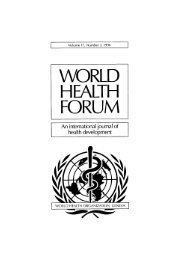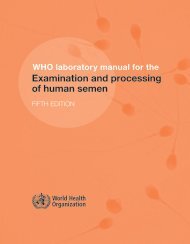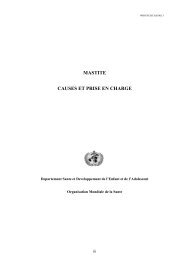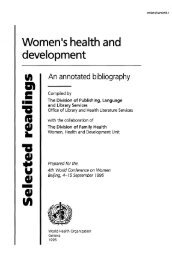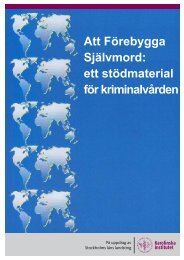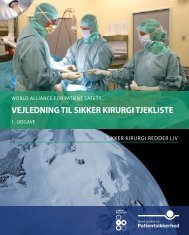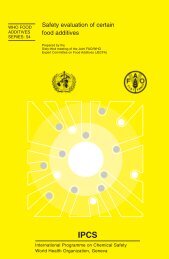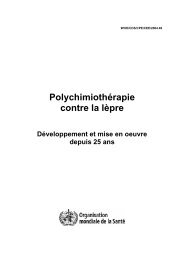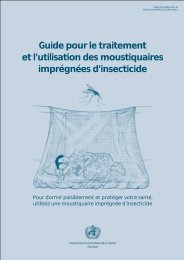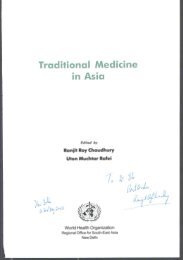smallpox vaccine and vaccination in the intensified ... - libdoc.who.int
smallpox vaccine and vaccination in the intensified ... - libdoc.who.int
smallpox vaccine and vaccination in the intensified ... - libdoc.who.int
Create successful ePaper yourself
Turn your PDF publications into a flip-book with our unique Google optimized e-Paper software.
540 SMALLPOX AND ITS ERADICATION<br />
Page<br />
The search for new <strong>vacc<strong>in</strong>e</strong>s 580<br />
Selection of vacc<strong>in</strong>ia virus stra<strong>in</strong>s of low patho-<br />
genicity 581<br />
Attenuated stra<strong>in</strong>s 583<br />
Inactivated <strong>vacc<strong>in</strong>e</strong>s 587<br />
Production of <strong>vacc<strong>in</strong>e</strong> <strong>in</strong> eggs <strong>and</strong> tissue culture 588<br />
Silicone o<strong>in</strong>tment <strong>vacc<strong>in</strong>e</strong> 590<br />
Efficacy of <strong>vacc<strong>in</strong>ation</strong> 590<br />
INTRODUCTION<br />
Vacc<strong>in</strong>ation aga<strong>in</strong>st <strong>smallpox</strong> had been<br />
practised <strong>in</strong> virtually every country of <strong>the</strong><br />
world, <strong>and</strong> <strong>in</strong> many on a large scale, when <strong>the</strong><br />
Intensified Smallpox Eradicat,ion Programme<br />
was launched <strong>in</strong> 1967. By its use, <strong>smallpox</strong> had<br />
already been elim<strong>in</strong>ated as an endemic disease<br />
from all but 31 countries. which constituted<br />
<strong>the</strong> hard core of <strong>the</strong> <strong>smallpox</strong> problem. It was<br />
clear that, <strong>in</strong> order to implement <strong>the</strong> pro-<br />
gramme, one of <strong>the</strong> first tasks of <strong>the</strong> WHO<br />
Smallpox Eradication unit would be to ensure<br />
that enough <strong>vacc<strong>in</strong>e</strong> was available, of suf-<br />
ficiently high titre <strong>and</strong> sufficiently heat-<br />
stable, to ensure that potent <strong>vacc<strong>in</strong>e</strong> could be<br />
delivered to those need<strong>in</strong>g <strong>vacc<strong>in</strong>ation</strong> <strong>in</strong> any<br />
place <strong>in</strong> <strong>the</strong> world, however remote <strong>and</strong><br />
however adverse <strong>the</strong> environmental con-<br />
ditions.<br />
Traditionally, <strong>smallpox</strong> <strong>vacc<strong>in</strong>e</strong> had been<br />
distributed <strong>in</strong> liquid form, although labora-<br />
tories <strong>in</strong> France <strong>and</strong> <strong>the</strong> Ne<strong>the</strong>rl<strong>and</strong>s East<br />
Indies (now Indonesia) had produced air-<br />
dried or freeze-dried <strong>vacc<strong>in</strong>e</strong>s from <strong>the</strong> 1920s<br />
onwards. Unless refrigerated, liquid <strong>vacc<strong>in</strong>e</strong><br />
did not reta<strong>in</strong> its potency for more than a few<br />
days whereas, until it was reconstituted,<br />
freeze-dried <strong>vacc<strong>in</strong>e</strong> rema<strong>in</strong>ed highly potent<br />
for over a month at ambient temperatures,<br />
even under tropical conditions. Dur<strong>in</strong>g <strong>the</strong><br />
period after <strong>the</strong> Second World War, freeze-<br />
dried <strong>vacc<strong>in</strong>e</strong> prepared <strong>in</strong> France was be<strong>in</strong>g<br />
used <strong>in</strong> francophone Africa <strong>and</strong> by <strong>the</strong> mid-<br />
1950s producers <strong>in</strong> several countries had<br />
developed freeze-dried <strong>vacc<strong>in</strong>e</strong> production on<br />
a commercial scale. From 1959 onwards<br />
somewhat larger quantities of freeze-dried<br />
<strong>vacc<strong>in</strong>e</strong> began to be used for <strong>smallpox</strong> vacci-<br />
nation <strong>in</strong> tropical countries, but its extensive<br />
use throughout <strong>the</strong> world dates from 1967-<br />
1968. After 1971 it was <strong>the</strong> only k<strong>in</strong>d of<br />
<strong>vacc<strong>in</strong>e</strong> used <strong>in</strong> any country engaged <strong>in</strong> a<br />
national <strong>smallpox</strong> eradication programme.<br />
In May 1980 <strong>the</strong> Thirty-third World<br />
Health Assembly, after it had declared that<br />
<strong>smallpox</strong> had been eradicated throughout <strong>the</strong><br />
world, recommended that <strong>smallpox</strong> vacci-<br />
nation should be discont<strong>in</strong>ued, except for <strong>in</strong>-<br />
vestigators at special risk. By 1985, <strong>smallpox</strong><br />
<strong>vacc<strong>in</strong>e</strong> production had been stopped <strong>in</strong> most<br />
countries <strong>and</strong> <strong>in</strong> no countrv <strong>in</strong> <strong>the</strong> world is<br />
<strong>smallpox</strong> <strong>vacc<strong>in</strong>ation</strong> rout<strong>in</strong>ely conducted <strong>in</strong><br />
<strong>the</strong> civilian population. Vacc<strong>in</strong>e reserves are<br />
be<strong>in</strong>g kept for emergencies by WHO <strong>and</strong> by<br />
<strong>the</strong> health authorities of some 20 countries<br />
(see Chapter 28). Thus <strong>smallpox</strong> <strong>vacc<strong>in</strong>ation</strong><br />
has gone full circle. Introduced by Jenner <strong>in</strong><br />
1798. it came to be used all over <strong>the</strong> world<br />
until, with <strong>the</strong> eradication of <strong>the</strong> disease that<br />
it was designed to control, its use has now<br />
been ab<strong>and</strong>oned, except for military person-<br />
nel <strong>in</strong> some countries. Jenner's prediction,<br />
<strong>in</strong> <strong>the</strong> paper reproduced <strong>in</strong> Chapter 6, that<br />
". . . <strong>the</strong> annihilation of <strong>the</strong> Small Pox. <strong>the</strong><br />
most dreadful scourge of <strong>the</strong> human species,<br />
must be <strong>the</strong> result of this practice" has been<br />
fulfilled, mak<strong>in</strong>g <strong>smallpox</strong> <strong>vacc<strong>in</strong>ation</strong><br />
redundant.<br />
An <strong>in</strong>terest<strong>in</strong>g sequel to this history of <strong>the</strong><br />
rise <strong>and</strong> fall of <strong>smallpox</strong> <strong>vacc<strong>in</strong>ation</strong> is that<br />
vacc<strong>in</strong>ia virus is currently show<strong>in</strong>g consider-<br />
able promise as a vector for genes specify<strong>in</strong>g<br />
protective antigens aga<strong>in</strong>st a variety of o<strong>the</strong>r<br />
<strong>in</strong>fectious agents (see box). If <strong>the</strong> results<br />
of current research fulfil expectations,<br />
"<strong>smallpox</strong>" <strong>vacc<strong>in</strong>e</strong> may make a comeback as a<br />
vehicle for provid<strong>in</strong>g simultaneous active<br />
immunization aga<strong>in</strong>st a number of selected<br />
"<br />
viral or protozoa1 diseases. It has <strong>the</strong> advan-<br />
tages of heat stability <strong>and</strong> ease of adm<strong>in</strong>istration.<br />
but <strong>the</strong> risk of com~lications will need to<br />
be carefully weighed <strong>and</strong> perhaps a more<br />
attenuated stra<strong>in</strong> sought (Qu<strong>in</strong>nan, 1985).<br />
In this chapter, various aspects of <strong>vacc<strong>in</strong>e</strong><br />
production <strong>and</strong> <strong>vacc<strong>in</strong>ation</strong> will be described<br />
<strong>in</strong> terms of practices that came <strong>in</strong>to operation<br />
after <strong>the</strong> Intensified Smallpox Eradication




